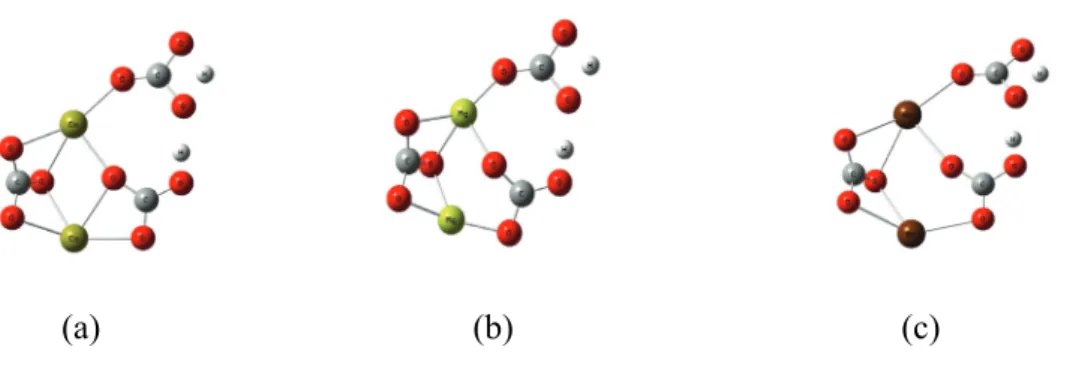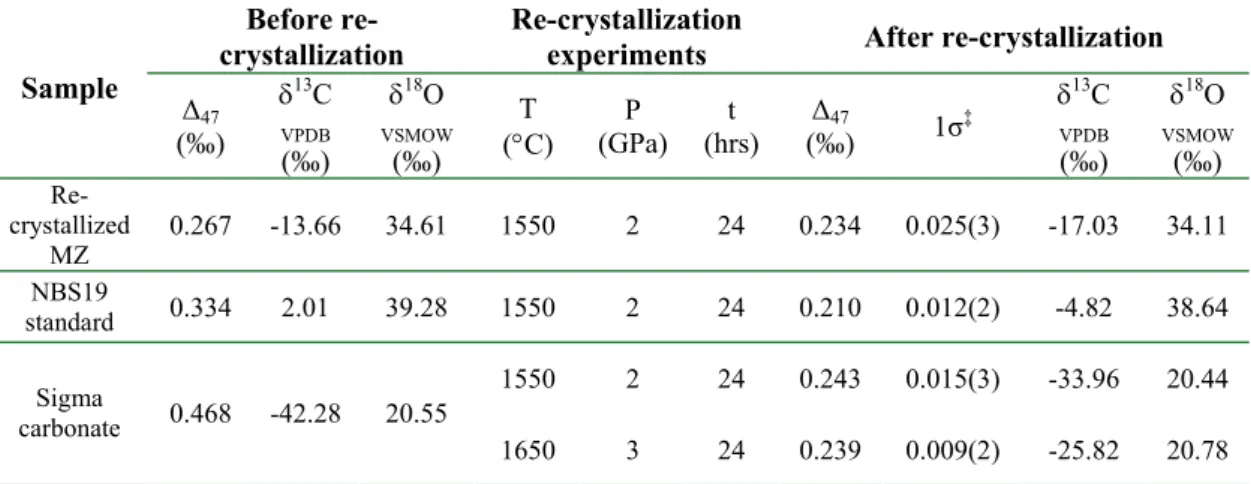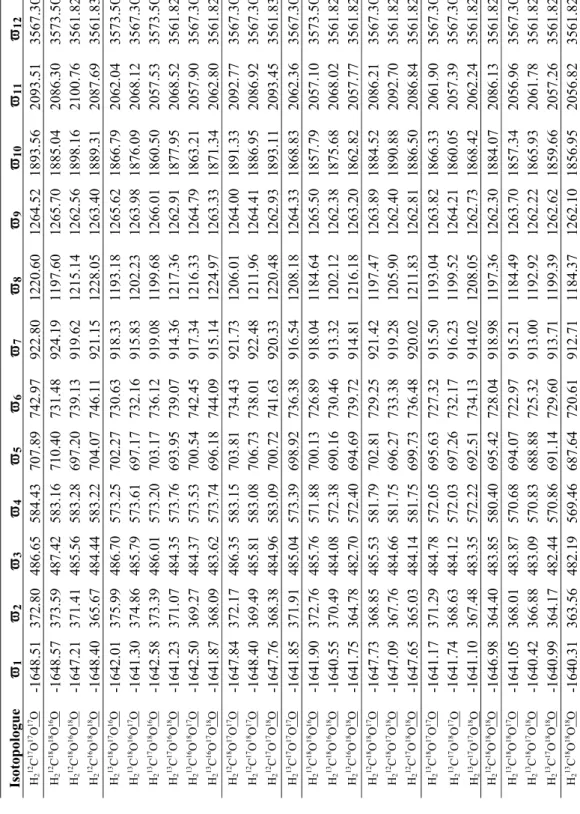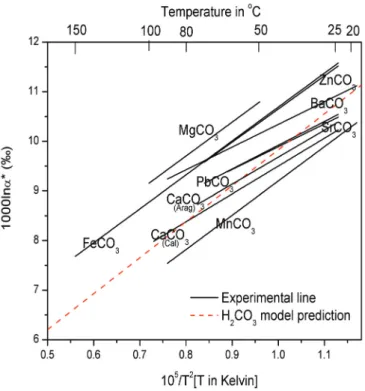The general success of our models in capturing the main features of isotope fractionation during acid digestion suggests that phosphoric acid digestion of carbonate minerals involves disproportionation of transition state structures containing H2CO3. Our understanding of acid digestion fractionations is particularly poor relative to the carbonate 'clumped isotope' thermometer (Ghosh et al., 2006).
Application of transition state theory to phosphoric acid digestion of carbonate minerals
Numbers refer to the atom's isotopic mass, in AMU; (e–g) three possible transition state structure isotopomers during the phosphoric acid digestion of 12C18O16O16O2-. 3-1, and the underlined atoms (atom 4) are those to be abstracted during the phosphoric acid digestion.
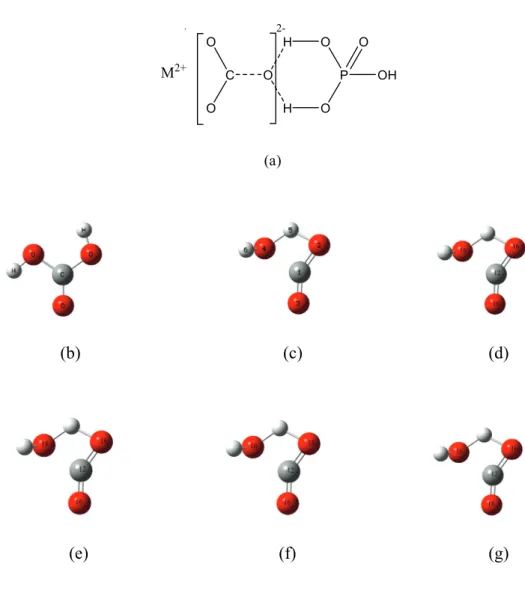
Computational methods
Therefore, we used a universal frequency scale factor of 0.9614, which has previously been shown to be suitable for B3LYP/6-31G* calculations (Scott and Radom, 1996). No frequency scaling was applied for the cluster model calculations, due to the lack of a universal scaling factor for the LACV3P basis set.
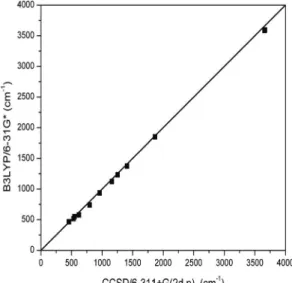
E XPERIMENTAL M ETHODS
R ESULTS AND D ISCUSSION
Experimentally determined acid-digestion fractionation of Δ 47
We assume that heating CaCO3 to temperatures and pressures above its melting point should drive its 13C and 18O toward a stochastic distribution. Thus, we expect that the Δ47 value of the CO2 extracted from CaCO3 quenched from the melt should be equal to 0 (the stochastic value) plus any fractionation associated with phosphoric acid digestion. There is no simple way for us to prove that stochastic distribution in carbonate is preserved during rapid quenching of a melt, but this seems a reasonable inference given previous evidence that isotopic redistribution in crystalline calcite is inefficient on laboratory time scales, even at high temperatures. Ghosh et al., 2006).
The Δ47 values of CO2 gases derived from these CaCO3 samples average σ), and show no systematic difference between the experiments at 1550°C/2Gpa and at 1650°C/3Gpa, nor any correlation with the Δ47 values of CO2 recovered from these samples before recrystallization (Table 2; note that such a correlation was observed by Ghosh et al., 2006, in the products of solid-state recrystallization experiments, leading them to conclude that such treatment only led to a partial approach to the stochastic distribution). These results support our conclusion that our heating experiments succeeded in driving these samples to a stochastic distribution, thus suggesting that the fractionation of 'lumpy isotope' of 13C-18O bonds during phosphoric acid digestion of calcite corresponds to an increase in ∆ 47 of 0.23‰ at 25°C. Numbers in parentheses indicate the number of independent replicate extraction and isotopic analyzes of the carbonate samples after recrystallization.
Model results for the oxygen-isotope and clumped-isotope fractionations associated with carbonic acid dissociation
3-4 and Table 3-4 present the oxygen isotope fractionations accompanying phosphoric acid digestion over a range of relevant temperatures, as predicted by our transition state theory model. The temperature sensitivity of our predicted oxygen isotope fractionation during phosphoric acid digestion (-0.055‰/°C at 25°C) is also only slightly above the range of temperature sensitivities experimentally determined for different carbonate minerals (MnCO3 appears to have the highest temperature sensitivity). of oxygen isotope aids digestion fractionation, -0.052‰/°C at 25°C). Our transition state theory model of phosphoric acid digestion predicts that CO2 produced by dissociation of an H2CO3 intermediate has an abundance of 13C-18O bonds, as reflected by the Δ47* value, +0.220‰ higher than the ∆63 -value of reactant carbonate at 25°C, with a temperature sensitivity of -0.0010‰/°C over the temperature range from 25°C to 80°C (Fig. 3-5).
Our transition state theory model also predicts the mass dependence of the oxygen isotope fractionation accompanying phosphoric acid dissolution. This is important for analyzes of the bulk isotopic compositions of the reactant carbonates because the fractionation mass dependence of the acid solution must be assumed in order to ion correct the measured CO2 product mass spectrum. To our knowledge, there are no experimental determinations of λ associated with phosphoric acid digestion of carbonate minerals; a value of 0.528 has been suggested (Assonov and Brenninkmeijer, 2003; Miller et al., 2007).
This value of λ characterizes the isotopic variations of natural waters (Li and Meijer, 1998; Barkan and Luz, 2005), and is thought to be inherited by carbonate minerals that form in isotopic equilibrium with natural waters, although there is no reason to suppose that also is characteristic of the acid digestion reaction process by which carbonates are measured. Our transition state theory of phosphoric acid digestion predicts that the value of λ associated with its isotopic fractionations is 0.5281.
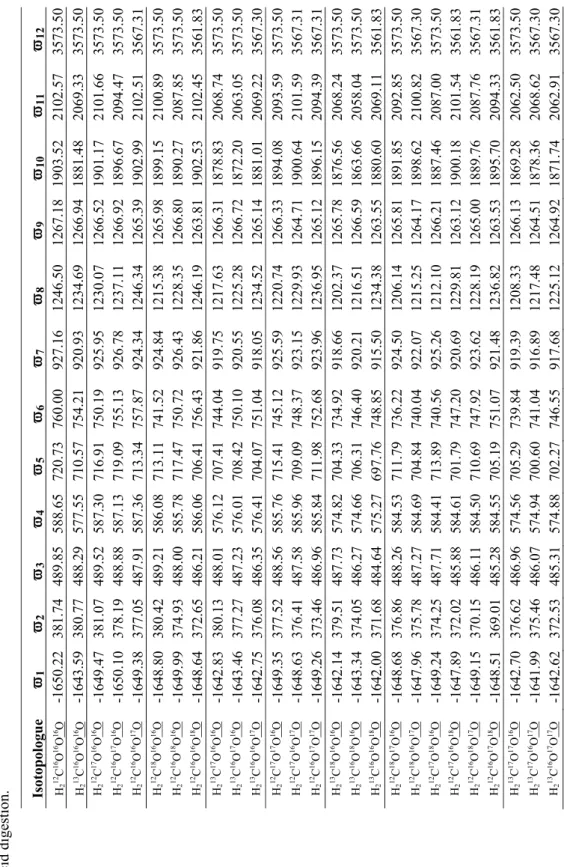
Dependence of acid digestion fractionations on the isotopic compositions of reactant carbonate minerals?
Interestingly, we find that these observed correlations may help explain the discrepancies between independent determinations of acid digestion fractionation factors. For example, the oxygen isotope acid digestion fractionation for octavite determined by Sharma and Clayton at 25°C follows the trend of fractionation versus the relatively small acid digestion fractionation determined for calcite by Sharma and Clayton (1965) may also be consistent. with such a trend (Fig. 3-6).
On the other hand, the discrepancy between these two studies in the acid solubility fractionation for witherite cannot be explained in this way. We observe no dependence of oxygen isotope acid solubility fractionation (1000lnα*) on the δ18O value of the reactant carbonate, and thus our model does not provide an explanation for such trends in the experimental data of Kim and O'Neil (1997 ). However, for the fractionation of the total mass 47 isotopologues,. f f f f are the relative abundance fractions of. such as specific isotopologue fractionations during phosphoric acid digestion.
As mentioned above, the ∆i* values are independent of ∆i of the reactant carbonate and only a function of the acid digestion temperature, and thus can be considered constant at a given temperature. Assuming that calcite has the same dependence of ∆47* on ∆63 as predicted by our H2CO3 model above, we predict that the Δ47 of CO2 produced by acid digestion of calcite will have a temperature sensitivity of C, which is closer to the C that was determined experimentally by Ghosh et al.
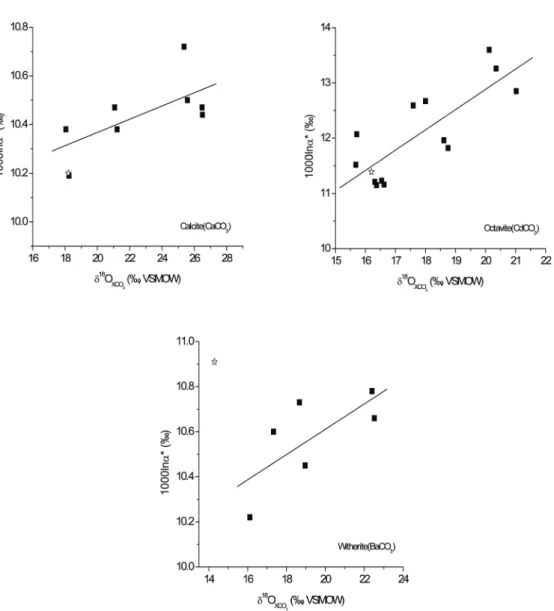
Cation effects on acid digestion fractionations
Previous attempts (e.g., Bottcher 1996 and Gilg et al., 2003) to understand variations in acid dissolution fractionation among different carbonate minerals examined empirical correlations between the intercept in a plot of 1000lnα* vs. We focus on the differences of 1000l of different carbonate minerals at a given temperature (eg, 25°C) and its temperature dependences separately, which we think are more likely to reflect differences in kinetic isotope effects related to the dissolution of phosphoric acid. To examine possible cation mass effects on acid solvation fractionation, we adopt a strategy similar to that used by Schauble et al. 2006) in their discussion of equilibrium carbon and oxygen isotope fractionations among various carbonate minerals and create two hypothetical isotopic carbonates, 40MgCO3 and 40BaCO3.
Based on the above analyses, we conclude that the fractionation difference upon acid digestion between calcite and aragonite is very small, approximately 0.1‰. This suggests that crystal structure, like cation mass, exerts only a very weak control on acid digestion fractionation. The fact that our cluster model, which did not take into account the effects of crystal structure, managed to reproduce semi-quantitatively the general trend of variations in acid digestion fractionations between different carbonate minerals (Fig. 3-7) also supports this argument.
Regarding oxygen isotopic acid digestion fractionations, our cluster model appears to underestimate the absolute values of Δ47*. We observe that values of Δ47* predicted by our cluster model correlate negatively with their respective predicted 1000lnα* fractionations during phosphoric acid digestion (Figs. 3–9). The method outlined above to estimate Δ47* for various carbonate minerals requires experimental data on their oxygen isotope acid digestion fractionation (ie 1000lnα*(XCO3, T) in the above equation) and is thus affected by the significant uncertainties associated with the experimental determination of 1000lnα* .
Given the success of our clustering model in capturing the general trend of variations of oxygen isotope acid digestion fractionation among different carbonate minerals (Figs. 3–7, Section 4.3), we assume that the clustering model predicted Δ47* also represents the actual trend of Δ47* variation between various carbonate minerals despite the apparent underestimation.
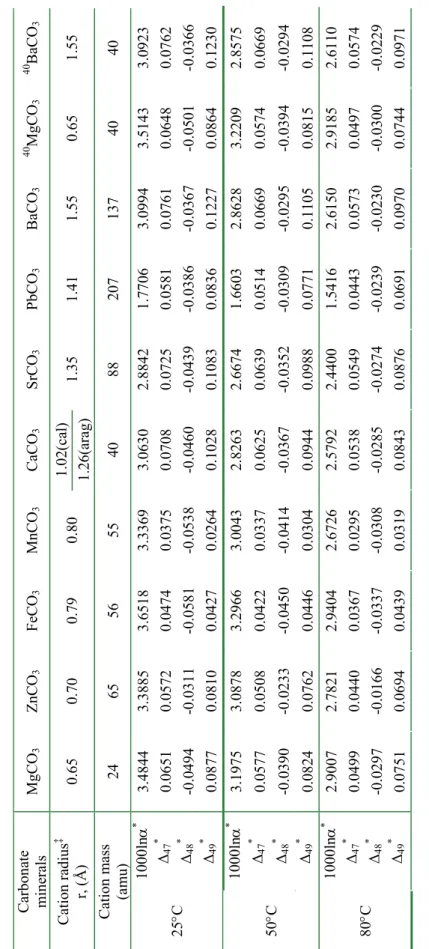
S UMMARY
These “cluster models” underestimate the magnitude of isotope fractionations associated with phosphoric acid digestion by a factor of ~3, presumably because we have misdescribed the structure of nearest neighbor interactions between the H2CO3 reaction intermediate and the reacting mineral surface. Nevertheless, our cluster models reproduce the general trend of variations (both in magnitude and temperature sensitivity) of oxygen isotope acid digestion fractionation among different carbonate minerals, suggesting that the general conceptual framework we followed in our models is broadly correct. 18O/16O and 13C/12C fractionation during the reaction of carbonates with phosphoric acid: effects of cationic substitution and reaction temperature.
Isotopic and trace element geochemistry of dolomite: state of the art. In SEPM Special Publications. A general algorithm for correcting 17O abundances in 13C/12C determinations from isotopologue measurements of CO2, including CO2 characterized by 'mass-independent' oxygen isotope distributions. Performance of effective core potentials of Ca, Hg and Pb in complexes with ligands containing N and O donor atoms.
Development and application of oxygen and carbon isotopic measurements of biogenic carbonates by ion microprobe. Fractionation of the stable isotopes of oxygen and carbon into carbon dioxide during the reaction of calcite with phosphoric acid as a function of temperature and technique.
A PPENDIX
A full calculation of these 16 equilibrium constants for multiply substituted isotopologs in carbonate lattices, such as Schauble et al. Instead, we calculate the corresponding equilibrium constants for an isolated CO32 ion in the gas phase, and use these to approximate the equilibrium constants in the carbonate lattice. The distribution of polysubstituted isotopologues within the two is remarkably similar (e.g. at an equilibrium temperature of 300 K, K in isolated CO32-, this study; versus K in calcite lattice, Schauble et al. 2006), and therefore this approach will not reveal significant systematic introduce errors into our model results.
The geometry optimization and frequency calculation for the isolated CO32 ion is performed at the DFT-B3LYP/6-31G* level, and the frequencies are scaled with the universal scaling factor of 0.9614 as described in Section 2.3 (Table 3-A1). We combine the above equations with the constraints from the bulk isotopic composition of the CO32 ion. By simultaneously solving these 20 equations (using the fsolve function of the MATLAB program, version 7.04), we obtain the abundances of all 20 isotopologues at specified bulk isotopic composition and equilibration temperature (Table 3-A2).

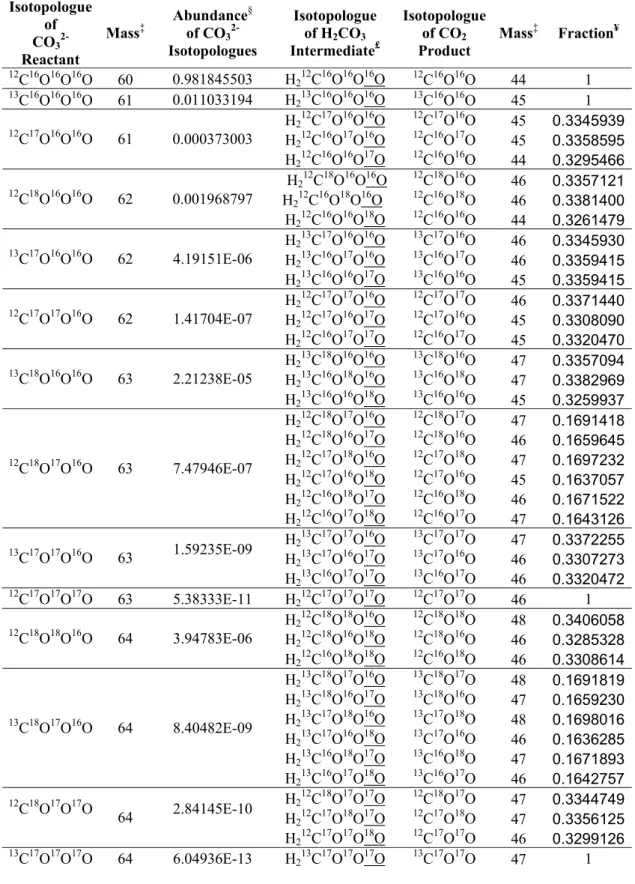
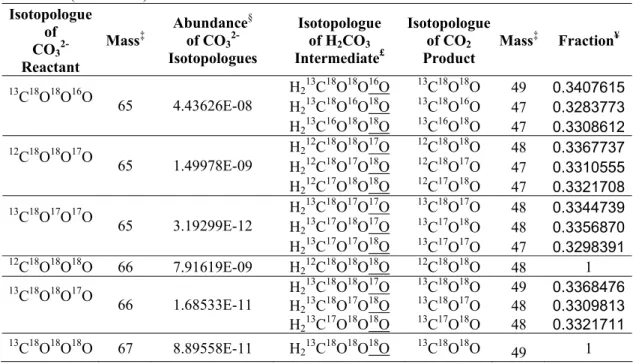
![Fig. 3-1g); and [H 2 12 C 16 O 16 O 18 O], [H 2 12 C 18 O 16 O 16 O], [H 2 12 C 16 O 18 O 16 O] are the abundances of the different isotopomers of H 2 12 C 18 O 16 O 2](https://thumb-ap.123doks.com/thumbv2/123dok/10409563.0/18.892.170.756.363.652/fig-1g-h-12-c-abundances-different-isotopomers.webp)
